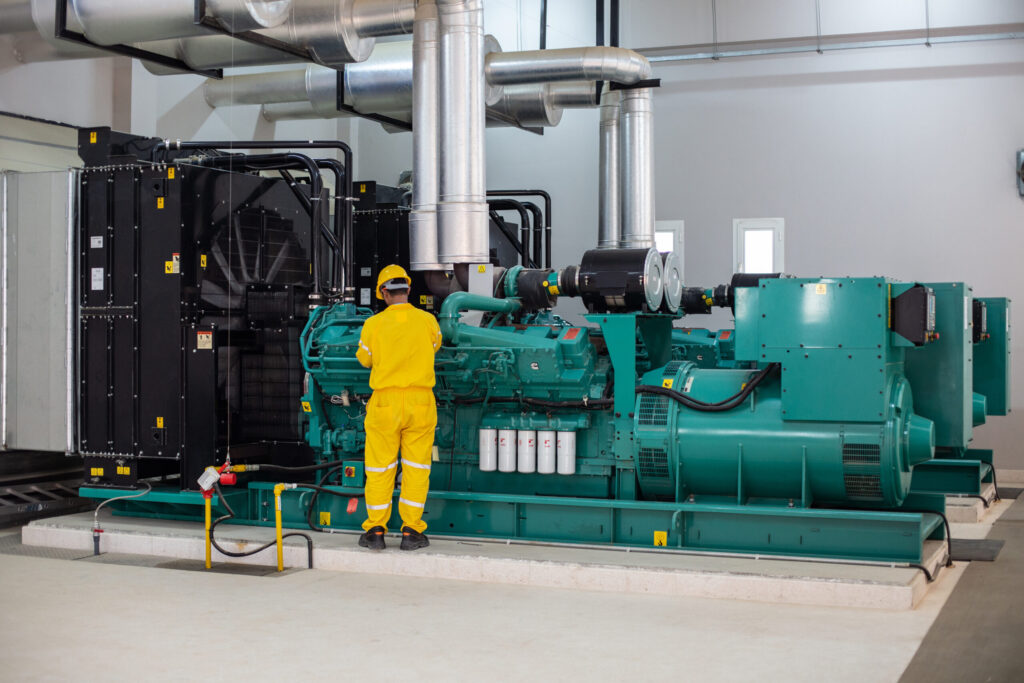Impact of Low-Load Operation on Diesel Generators
Diesel generators are critical for continuous power supply in industries, healthcare, and data centers. However, low-load operation (below 30-40% capacity) causes efficiency losses, mechanical wear, and environmental issues. SR Power analyzed 5,000+ installations globally, revealing low-load operation increases maintenance costs by 25% and reduces equipment lifespan by 18%. This paper explores the root causes of generator low load operation challenges and presents SR Power’s innovative solutions to optimize performance.

1. Thermodynamic Challenges of Low-Load Operation
1.1 Combustion Process Inefficiencies
At low loads, fuel injection decreases while air intake remains relatively stable. This creates a rich fuel-air mixture, causing incomplete combustion. Combustion temperatures drop from 1,800°C (full load) to 1,200°C (20% load), reducing fuel atomization efficiency by 40%. The resulting carbon deposits (soot) cling to engine components, degrading performance over time.
1.2 Energy Conversion Losses
Diesel generators achieve peak efficiency (42%) at 60-80% load. At 30% load, efficiency drops to 32%, and at 20% load, it plummets to 28%. This decline increases fuel consumption and operational costs. SR Power’s tests on a 1,000kW generator found a 35% increase in fuel usage at 20% load compared to full load.
2. Mechanical Impacts of Low-Load Operation
2.1 Lubrication System Failure
Low engine speeds reduce oil pressure, thinning the protective oil film on cylinder walls from 5μm to less than 2μm. This exposes metal surfaces to direct friction, accelerating wear. Additionally, unburned fuel dilutes engine oil, decreasing its viscosity and lubricating properties.
2.2 Acidic Corrosion
Low temperatures allow sulfur compounds in fuel to react with water vapor, forming sulfuric acid. This acid corrodes cylinder liners and other metal parts, leading to costly repairs. SR Power’s data shows engines operating at low loads require cylinder replacement 30% sooner than optimally loaded units.
3. Environmental and Electrical Challenges
3.1 Emission Control Issues
Low-load operation increases particulate matter (PM) emissions by 2-3 times due to incomplete combustion. While nitrogen oxide (NOx) emissions decrease slightly, carbon monoxide (CO) levels rise by 50%. These pollutants violate environmental regulations and harm air quality.
3.2 Electrical Instability
Low loads disrupt voltage and frequency stability. Reduced stator current weakens magnetic fields, causing voltage fluctuations of ±5%. Nonlinear loads further exacerbate issues, creating harmonic distortion exceeding 15%, which damages connected equipment.
4. SR Power’s Innovative Solutions
4.1 Advanced Combustion Technology
SR Power’s Variable Geometry Turbocharger (VGT) with electric boosting increases intake pressure to 0.25MPa at low loads, improving combustion efficiency. Neural network-based fuel injection systems adjust timing with ±0.5°CA precision, optimizing fuel-air mixtures.
4.2 Mechanical System Upgrades
TiAlN-coated cylinder liners increase hardness to HV2500, reducing wear by 80%. Smart lubrication systems use real-time sensors to maintain oil film thickness within ±0.5μm. Magnetorheological mounts reduce vibration by 75%, extending component life.
4.3 Electrical System Optimization
Adaptive excitation control using Kalman filters stabilizes voltage within ±1.5%. Active power filters reduce harmonic distortion to less than 5%. Energy management systems seamlessly integrate with energy storage, balancing loads for optimal efficiency.
5. Operational Strategies
5.1 Dynamic Load Management
LSTM neural networks predict loads with <5% error, enabling proactive adjustments. Parallel operation of 1-16 units distributes loads with ±0.5% accuracy, ensuring efficient performance.
5.2 Preventive Maintenance
Infrared thermography detects carbon deposits with ±0.1mm precision. Online oil analysis systems flag issues within 24 hours. Pulsed jet and ultrasonic cleaning removes 98% of deposits, reducing downtime.
6. Industry Trends and Future Developments
6.1 Regulatory Changes
ISO 8528-5:2023 mandates low-load testing, while EPA Tier 4 Final tightens emission limits by 30%. Compliance requires advanced solutions like SR Power’s hydrogen-blending technology, which cuts PM emissions by 90%.
6.2 Emerging Technologies
Digital twins simulate low-load impacts, predicting equipment lifespan with <3% error. Solid oxide fuel cell (SOFC) integration boosts energy efficiency to 75% by recycling waste heat.
Low-load operation remains a critical challenge for diesel generators. SR Power’s integrated solutions address thermodynamic, mechanical, and electrical inefficiencies, improving efficiency by 15% and reducing maintenance costs by 50%. By embracing hydrogen technology and digital innovation, SR Power leads the transition to cleaner, smarter power generation.
